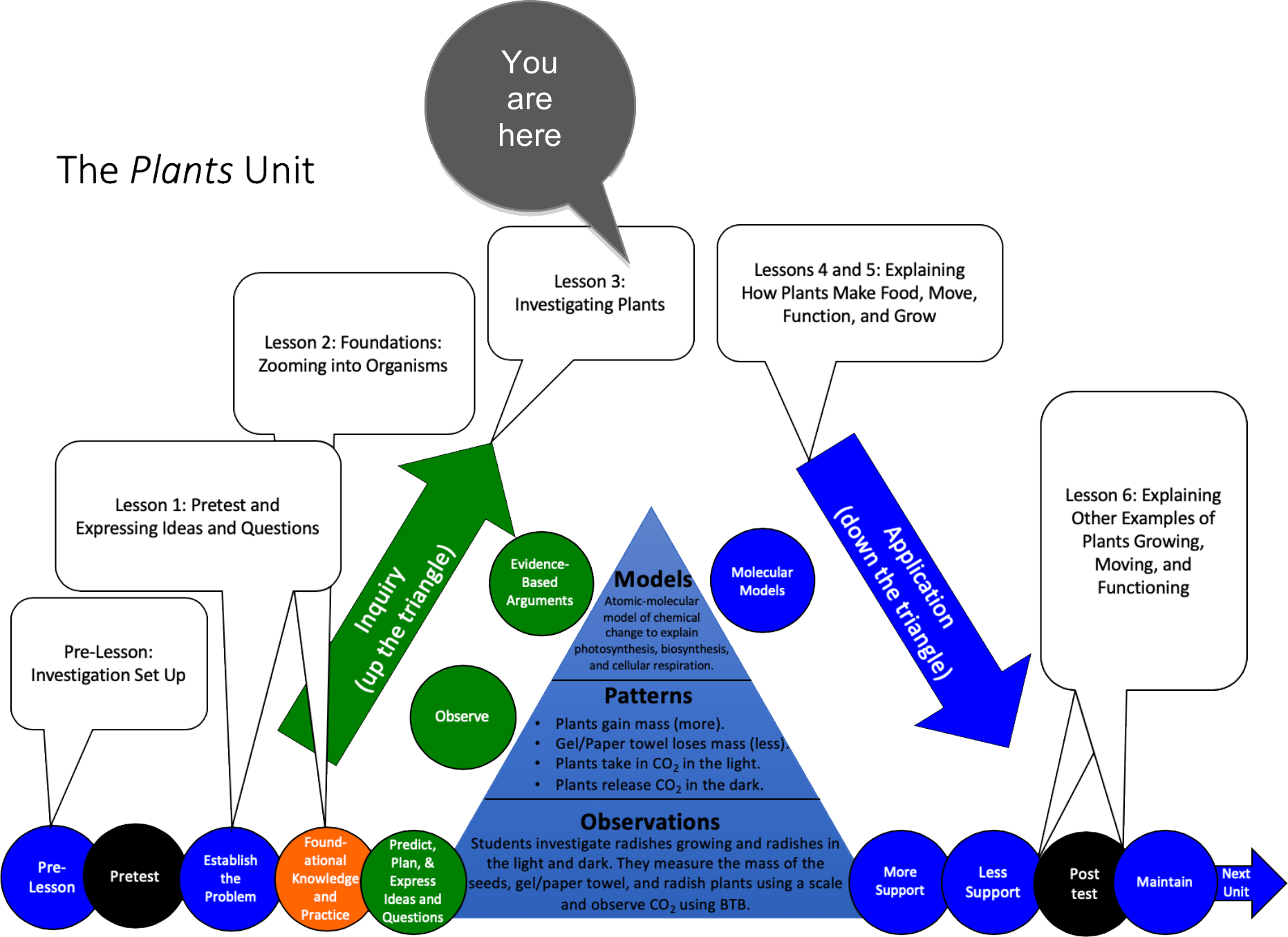Transformations in Matter and Energy Carbon TIME is an NSF-funded partnership led by Michigan State University
Plants | Lesson 3 - Investigating Plants
Students conduct an investigation about plants in the light and dark and about mass changes. The focus of this lesson is to make observations and prepare data to be used as evidence for their explanations in Lessons 4 and 5.
Guiding Question
What happens when plants are left in the light and in the dark, and where does a plant’s mass come from?
Activities in this Lesson
Note: There are two different pathways to choose from in Lesson 3. Please see the Plants Unit Front Matter and/or the Background Information section below for clarification in making this instructional decision.
- Activity 3.1: Predictions and Planning about Radish Plants Growing (50 min)
- Activity 3.2: (GL or PT): Observing Plants’ Mass Changes, Part 1 (30 min)
- Activity 3.3: Observing Plants in the Light and Dark (60 min)
- Activity 3.4: (GL or PT): Observing Plants’ Mass Changes, Part 2 (45 min)
- Activity 3.5: Evidence-Based Arguments About Plants (50 min)
Unit Map

Target Performances
|
Activity |
Target Performance |
|
Lesson 3 – Investigating Growing Radish Plants (students as investigators and questioners) |
|
|---|---|
|
Activity 3.1: Predictions and Planning about Radish Plants Growing |
Students develop hypotheses about how matter moves and changes and how energy changes when radishes move and grow and make predictions about how they can use their investigation tools—digital balances and BTB—to detect movements and changes in matter. |
|
Activity 3.2 (PT or GL): Observing Plants’ Mass Changes, Part 1 |
Students harvest their radish plants and dry down the plants and the paper towel or gel in preparation for Activity 3.4. |
|
Activity 3.3: Observing Plants in the Light and Dark |
Students observe how plants affect BTB in the light and dark, identify patterns in data, and reach consensus with other groups about their results. |
|
Activity 3.4 (PT or GL): Observing Plants’ Mass Changes, Part 2 |
Students measure the dry weight of harvested plants and of paper towels or gel, identify patterns in data, and reach consensus with other groups about their results. |
|
Activity 3.5: Evidence-Based Arguments about Plants |
Students (a) use data from their investigations to develop evidence-based arguments about how matter moves and changes and how energy changes when plants grow, move, and function; and (b) identify unanswered questions about matter movement and matter change that the data are insufficient to address. |
NGSS Performance Expectations
Middle school
- MS. Structure and Properties of Matter. MS-PS1-1. Develop models to describe the atomic composition of simple molecules and extended structures.
- MS. Chemical Reactions. MS-PS1-2. Analyze and interpret data on the properties of substances before and after the substances interact to determine if a chemical reaction has occurred.
- MS. Chemical Reactions. MS-PS1-5. Develop and use a model to describe how the total number of atoms does not change in a chemical reaction and thus mass is conserved.
- MS. Matter and Energy in Organisms and Ecosystems. MS-LS1-7. Develop a model to describe how food is rearranged through chemical reactions forming new molecules that support growth and/or release energy as this matter moves through an organism.
- MS. Matter and Energy in Organisms and Ecosystems. MS-LS2-3. Develop a model to describe the cycling of matter and flow of energy among living and non-living parts of an ecosystem.
High school
- HS. Chemical Reactions. HS-PS1-4. Develop a model to illustrate that the release or absorption of energy from a chemical reaction system depends upon the changes in total bond energy.
- HS. Chemical Reactions. HS-PS1-7. Use mathematical representations to support the claim that atoms, and therefore mass, are conserved during a chemical reaction.
- HS. Structure and Function. HS-LS1-2. Develop and use a model to illustrate the hierarchical organization of interacting systems that provide specific functions within multicellular organisms.
- HS. Matter and Energy in Organisms and Ecosystems. HS-LS1-5. Use a model to illustrate how photosynthesis transforms light energy into stored chemical energy.
Talk and Writing
At this stage in the unit, the students will complete the inquiry sequence for Plant Investigations—they will go up the triangle. This means they will go through the Predictions Phase, the Observations Phase, and the Evidence-Based Arguments Phase. The tables below show specific talk and writing goals for these phases of the unit.
|
Talk and Writing Goals for the Predictions Phase |
Teacher Talk Strategies That Support This Goal |
Curriculum Components That Support This Goal |
|---|---|---|
|
Treat this as elicitation and brainstorming (like the Expressing Ideas Phase), but with more directed questioning. |
Now that we have set up the investigation, we want to predict what we think will happen to matter and energy. |
Three Questions Handout Predictions and Planning Tool |
|
Elicit a range of student ideas. Press for details. Encourage students to examine, compare, and contrast their ideas with the ideas of other students. |
Who can add to that? What do you mean by _____? Say more. So I think you said _____. Is that right? Who has a different idea? How are those ideas similar/different? Who can rephrase ________’s idea? |
Investigation Video (selected sections) |
|
Encourage students to provide evidence that supports their predictions. |
How do you know that? What have you seen in the world that makes you think that? |
|
|
Have students document their ideas to revisit later. |
Let’s record our ideas so we can come back to them and see how our ideas change. |
Predictions and Planning Tool |

 Download PDF of Lesson 3 Teacher's Guide
Download PDF of Lesson 3 Teacher's Guide